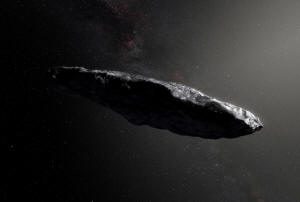Scientists explain alien comet 'Oumuamua's strange acceleration
 Send a link to a friend
Send a link to a friend
 [March 24, 2023]
By Will Dunham [March 24, 2023]
By Will Dunham
WASHINGTON (Reuters) - The quirky comet 'Oumuamua, the first
interstellar object found visiting our solar system, has been the
subject of fascination since being spotted in 2017, including its
curious acceleration as it hurtled away from the sun.
Hypotheses were floated in light of its unexpected behavior, including
fleeting speculation that it might actually have been an alien
spacecraft. A new study has offered a more sober explanation - that 'Oumuamua's
speed-up was due to the release of hydrogen gas as the comet warmed up
in the sunlight.
'Oumuamua (pronounced oh-MOO-uh-MOO-uh) lacks the tail of gas and dust
characteristic of many comets. It was previously described as being
cigar-shaped but now is thought to resemble a rocky pancake. Smaller
than originally estimated, it is now pegged at approximately 375 feet
(115 meters) by 365 feet (111 meters), with a thickness of about 60 feet
(19 meters).
Researchers said it appears that 'Oumuamua was born like many other
comets as what is called a planetesimal - a small object formed in the
early stages of planet formation - and was essentially a large, icy
space rock.
After it was somehow ejected from its solar system of origin, they said,
the comet's chemistry changed as it was bombarded by high-energy
radiation while venturing through interstellar space. This converted
some of the comet's ice - frozen water - into hydrogen gas that was
trapped within the rest of its ice.
'Oumuamua then was warmed up as it passed through our inner solar
system, causing the comet's ice structure to rearrange and releasing the
trapped hydrogen gas - giving 'Oumuamua a little bit of a kick as it
headed away from the sun. The release of this hydrogen in a process
called outgassing would not cause a visible tail.
"The key finding is that 'Oumuamua may have started as a water-rich icy
planetesimal broadly similar to solar system comets. This model can
explain the strange behavior of 'Oumuamua without needing to resort to
any exotic physics or chemistry," said University of California,
Berkeley astrochemist Jenny Bergner, lead author of the research
published this week in the journal Nature.
[to top of second column]
|

This artistís impression shows the first
interstellar asteroid, `Oumuamua as it passes through the solar
system after its discovery in October 2017. European Southern
Obervatory/M. Kornmesser/Handout via REUTERS

"The simplest explanation, and exactly what we would expect for an
interstellar comet, fits all of the data with no fine-tuning," said
study co-author Darryl Seligman, a postdoctoral fellow in planetary
science at Cornell University.
'Oumuamua, whose name refers in the native Hawaiian language to a
messenger arriving from a great distance, was first detected by the
University of Hawaii's Pan-STARRS1 telescope.

"We don't know its place of origin but it was probably traveling
through interstellar space for less than 100 million years. It had a
reddish color consistent with the colors of many small bodies in the
solar system. It is currently past Neptune on its way out of the
solar system," Bergner said.
A second interstellar object, the comet 2I/Borisov, was discovered
visiting our solar system in 2019. This one looked and behaved more
like a typical comet.

These alien interlopers may be more common than previously known.
The researchers said one to two interstellar objects may be
discovered every year in our solar system once a new astronomical
observatory now being built in Chile begins operations as planned
next year.
(Reporting by Will Dunham, Editing by Rosalba O'Brien)
[© 2023 Thomson Reuters. All rights
reserved.]This material may not be published,
broadcast, rewritten or redistributed.
Thompson Reuters is solely responsible for this content. |